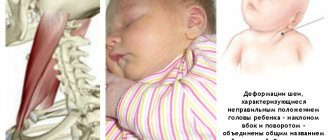Feeding positions
In the Soviet Union, doctors taught a woman one single correct posture, when she is in a sitting position, with a pillow under her back and a bench under her feet. It was believed that this was the only way it would be convenient for both the child and the nurse herself. Doctors were convinced that this body position ensures better milk flow, which prevents the occurrence of painful stagnation.
It was customary to feed children by the hour, which some parents still adhere to today. But in today's pediatrics this approach is recognized as incorrect. It has long been proven that the position of a woman during breastfeeding has no effect on the supply of milk.
Breasts should be given on demand and positions can be changed during lactation; there is no need to support the breasts with your hand. Today, every pediatrician will confidently say that it is better to feed a child in a position that is primarily comfortable for the mother herself.
Before feeding, there are a number of tips to consider:
- Take a comfortable position. It is necessary to relax the shoulder girdle for better milk release. Haste, fuss, stress contribute to the deterioration of lactation. During the postpartum period, some women are not recommended to sit, so they need to feed in a lying position.
- Correct positioning of the baby at the breast. The woman should be in a position where the nipple and the baby’s mouth are at the same level. This will help avoid injury to the delicate skin of the areola, because the baby will not have to pull on the breast. There is no need to specifically fix the baby's head.
- Do not squeeze the mammary glands. When sucking, the baby's nose may bury itself in the chest and the mother may feel that it is now difficult for him to breathe. But in fact, air enters through the edge of the nasal passage, and squeezing the glands significantly impairs the outflow of milk.
- Attachment of the baby. The newborn's reflex is triggered, in which he easily grabs the breast. Only during the first attempts, the mother needs to help the baby a little, gently moving part of the areola along the upper lip. If you insert the nipple directly into the baby's mouth, he will subsequently not develop the desire to reach the breast on his own.
How to properly attach a baby to the breast - for this you can use the “Cradle” pose in different variations, “From under the arm”, “Lying in your arms”, “Hanging”, “Baby on the mother’s stomach”.
"Lullaby"
This position is most famous among young mothers due to its versatility and is equally comfortable for both a newborn and a one-year-old child. The baby is in the mother's arms in such a way that his head is in the crook of the elbow , and on the other side the woman holds the baby under the butt, hugging the back.
At this time, the child leans his stomach against his mother’s, and his mouth is at the level of the nipple. This position makes it quite possible to feed from both breasts in turn, shifting the baby.
You can feed a newborn by rocking him while the woman is standing or walking. This method can also be called one of the variants of the “Cradle” pose. At this time, the woman can slowly walk around the room or sway her torso while standing in one place. This way the baby will eat, calm down and quickly fall asleep.
Another variation of this position is the Cross Cradle. It is very similar to the classic method, but the main difference is the additional support for the newborn. The mother holds the baby's head with both hands.
This option of breastfeeding is considered correct when a woman needs to establish a correct latch on her baby.
Using your palms, you can easily control the position of the head and move it closer when your baby needs help grasping the areola. In general, children have a well-developed sucking reflex, but in some situations it may be underdeveloped, for example, if the child was born premature.
"Out of hand"
This position requires several pillows. A woman holds a child, pinching it under her armpit. The main condition is that the baby’s mouth should be strictly at the level of the nipple. With the correct position, the mother will not strain her back muscles, and as a result, fatigue will not occur.
How to properly attach a baby to the breast is where classes in schools for expectant mothers begin to teach feeding; it is advisable to use this option at least once daily, which will allow the newborn to suck milk from the lateral breast lobes.
This position is a great help for those women who are prohibited from sitting during the postpartum period. In this case, the mother's position is semi-lying, supported by the base of the forearm and thigh. The newborn is placed on a pillow perpendicular to the mother's body. In the “Under-arm” position, feeding can be done while sitting, the main thing is to put pillows on all sides so that the nurse is comfortable.
"Lying on the hand"
This position gives the woman the opportunity to rest during feeding. In this position, it is important that the mother's head is on the pillow and her shoulders are on the bed. At this time, the baby is on his side, and the mother holds him with her hand.
To make it easier for the baby to reach the mother's breast, it is best to place him on a pillow. During night feeding, a woman does not have to worry that she will put her body on the baby. For greater comfort, you can place an additional pillow under your back. This position has proven itself to be comfortable for peaceful sleep with your baby.
In this position, you need to feed from the breast that is located below. In this case, the mother removes her hand under her head and places a pillow behind the child’s back so that he does not roll, remaining on his side all the time.
"Overhang"
Here it is important that the baby is on his side, and the mother seems to be hanging over him. In this position, the baby’s task is easier, because the milk flows more easily through the ducts straight into the mouth. For a woman, the benefit of this option is that the lower and central thoracic lobes are released naturally. This position is only suitable for full breastfeeding.
This position also has its disadvantages, because the woman is not very comfortable, and she quickly gets tired of holding her back. Therefore, this position is not used often. This feeding can be done on a changing table, simply bending over the baby, or on the bed, standing on all fours in front of the baby.
"Baby on Mom"
This position is considered the most comfortable and useful for those women whose milk flows heavily. With a large flow, babies do not have time to swallow the milk and, in a hurry, begin to choke. So, the mother gets into a semi-lying position and places the baby on top of her. With this type of feeding, the flow will not be as strong and the baby will have to suckle on his own.
This position is especially suitable in the first few months after birth. Lactation at this time is just getting better; in most cases, milk comes in quickly and the streams are strong. When the baby is on top of the mother, it is easier to cope with milk flows.
Incorrect postures
How to properly attach a baby to the breast and understand that the position is chosen incorrectly is easy based on the simplest signs:
- back and lower back pain in women;
- the appearance of cracks and trauma to the nipple;
- the child strains greatly, trying to reach the mother’s breast;
- the baby does not eat enough due to a weak milk flow;
- poor-quality sucking process leads to a violation of the amount of milk production.
Discomfort and fatigue primarily indicate an incorrectly chosen position for lactation.
Criticism of WHO
Each country has its own characteristics of attaching a baby to the mother's breast. In many countries, including Russia, it is necessary to introduce complementary feeding starting from the age of three or four months. However, Soviet pediatricians advised starting to feed the baby from the second month of his life. In addition, a schedule was drawn up according to which breastfeeding should occur, which completely stopped by 11–12 months. Children's doctors of the USSR argued about the need to introduce fruits, vegetables, kefir, and freshly squeezed juices from 2 months. lactation.
Modern pediatricians are convinced of the opposite. They believe that complementary feeding at such an early age increases the likelihood of anemia in children. The optimal age for feeding such products is 6 – 7 months. It is allowed to introduce complementary foods a little earlier (after the baby reaches four or five months of age) if the baby was on artificial or mixed feeding. This will help the children's gastrointestinal tract quickly adapt to new food.
A breastfeeding woman must decide for herself whether to adhere to the recommendations (WHO). After all, every body is individual, only mommy can find the optimal, most convenient way to feed her baby. Improper latching of a baby to the breast can lead to deterioration of lactation, malnutrition, and discomfort.
Correct chest grip
It is quite simple to understand that a newborn is latching onto the breast correctly, paying special attention to the position of the baby’s gums, which should completely encircle the areola and nipple. Compressing the milk ducts under the areola promotes the flow of the required amount of milk.
If the breast is not grasped correctly, the woman will experience unpleasant painful sensations and it will all end in the appearance of cracks. As a result, feeding may be disrupted, and in the worst case, canceled altogether. When you first realize that the baby is not eating correctly, you should stop feeding, but only after finishing sucking to avoid damage.
Proper breast grip contributes to the following factors:
- Provides a flow of milk.
- Emptying the breasts occurs painlessly and quite quickly.
- Enables the baby to suckle effectively, resulting in the most nutritious milk possible.
- The nipple is not injured, which contributes to a longer period of breastfeeding.
The mother is faced with the task of teaching the child to latch onto the breast correctly, which may take several days.
Recommendations for mothers when breastfeeding
Key points affecting the quality and duration of breastfeeding:
- The first application no later than the first 2 hours after the birth of the child.
- For the first few months after birth, feeding should be done on demand.
- All babies eat at different times, so don’t wean after 15 minutes. Wait until the baby leaves the nipple on his own.
- During feeding, it is necessary to alternate breasts to completely empty the mammary glands on both sides.
- At the end of feeding, you need to express the remaining milk.
- If there is insufficient milk supply, feeding occurs from both mammary glands.
- More frequent application helps stimulate the mammary glands.
- Incompletely emptied mammary glands can lead to the formation of congestion, as a result of which the quality of lactation deteriorates.
- You can monitor your milk supply by weighing your baby before and after feeding.
- Breast milk is divided into fore and hind milk. In the first case, it contains more sugar, but less protein and fat, and is more liquid. Late milk has a high calorie content and is richer in vitamins.
- If a child receives only foremilk, it can cause abdominal pain and colic.
- It is not recommended to wash your breasts before each feeding, much less use soap for this. This removes the protective layer of the skin.
Convenient location for mom
One of the important nuances during feeding is the comfortable clothes that a woman wears in everyday life. In particular, underwear, which should quickly allow her to gain access to her breasts. For this purpose, there are special nursing bras, tops, and T-shirts. Therefore, you should not neglect them, they will significantly facilitate the daily ritual, your breasts will have support throughout the day.
When breastfeeding while lying on your side, the main thing is to find a support point that will help the mother evenly distribute the load. The main thing is that someone is nearby to provide assistance or the essentials are at hand. These can be pillows, a donut-shaped cushion, baby hygiene items (towel, diaper, napkins), and a pacifier. It is important to leave your cell phone nearby and put it in quiet mode, charger (preferably wireless). This is especially valuable when the baby falls asleep.
The main task for the mother in this process is to experience pleasant moments of unity with the child. Therefore, she should enjoy the joint process. This is a kind of act of communication that is available only to the two of them. The baby communicates by touching the mother's body, so during feeding there should be nothing that would interfere, distract or make him nervous. It’s worth putting off doing laundry, cooking, and making phone calls for a while.
Signs of proper feeding
The mother can help the child make the correct grip by touching his lips with the lower part of the areola. The baby will open his mouth wide, after which the lower lip should be directed just below the level of the nipple.
When sucking only the nipple, the baby will not receive the required amount of milk and will not be full. All this will lead to whims, anxiety, and in the worst case, complete rejection of the mother's breast. When the baby's feeling of hunger disappears, he lets go of the breast on his own and may even fall asleep.
How to properly and incorrectly attach a baby to the breast. Visual photos
| Correct grip | Incorrect grip |
| Nipple deep in mouth. The lower lip is turned out. |
|
| The baby's mouth is wide open. Most of the areola is captured. |
|
| Both lips are turned out. The cheeks are rounded. |
|
| The chin and tip of the nose are pressed to the chest. This point should be controlled by the mother. |
|
| The tongue does not move back and forth. The baby can be heard swallowing milk. |
|
How to make the process comfortable for your baby
For those who are puzzled by the question of how to properly breastfeed while lying down, it is recommended to prepare the space around it in advance. The main nuance on which comfortable feeding depends is the absence of haste and haste, the position of the baby on a clean diaper. The baby's head should be on a diaper folded separately in four layers. Under no circumstances should it fall back or be lowered. This way it will be possible to ensure a slight elevation of the head relative to the body.
You can hold the baby's body with your free hand, which will provide him with additional support and close contact with the mother's body. To determine the correct position of the baby relative to the mother, you need to look at what level his mouth is located. It should be opposite the nipple, which will allow you to gently guide it towards the breast, and not push it towards the baby.
If the baby is located close to the edge of the bed (or sofa), it is recommended to place a pillow rolled into a cushion shape on the side of his back. If a bolster is used to hold the child in a side-lying position, it should not rest against the head. Its length is equal to the length of the baby's body to the shoulders. It is also important to ensure that the baby’s movements are not limited, which can lead to unnecessary stress.
Cautions
Many young mothers, due to lack of experience, can make serious mistakes:
- Establishing a feeding schedule. In such cases, a woman may experience a disruption in the functioning of the mammary glands; milk will not be produced in sufficient quantities. This item is recommended only upon reaching the so-called adult lactation.
- Do not introduce artificial mixtures only because it seems to the mother that the child is not getting enough to eat. Only on the recommendations of the local pediatrician. The need to introduce complementary foods is determined by control weighing.
- Do not add water. Almost 90% of milk consists of water, so it is wrong to consider it exclusively food. If you suspect that the baby is thirsty, it would be better to further stimulate lactation by resorting to frequent feedings. Drinking too much can cause breast refusal. It is recommended to introduce water no earlier than 6 months. If the baby is initially bottle-fed, then you can give him additional drinks from the very beginning.
- Crying is not always a sign of hunger. This way the child simply attracts attention.
- The amount of milk does not depend on the density of the breast. This may indicate the appearance of stagnation and the beginning of lactostasis. Women's breasts should always be soft.
- Don't pump without special reasons. At this point, milk loses its beneficial part. A better alternative would be to offer your baby the breast again.
- If possible, avoid giving the pacifier for as long as possible. The child’s crying should be stopped by identifying the cause of the irritation.
- Complementary foods should be introduced no earlier than 6 months. Until this moment, breast milk is enough for the baby, with which he receives all the necessary vitamins and microelements.
The main thing is safety
In such a delicate issue as proper breastfeeding of a newborn while lying down, safety is an important aspect. Fatigue and inattention can cause a number of unpleasant and even tragic moments to develop. You should always remember about safety, especially when a woman is alone with her child.
So, where should you start and how to breastfeed your newborn while lying down to avoid falls and other troubles? It is never recommended to place an infant between two adults. No matter how sensitive the dream is, we should not forget about the phase when a person cannot control his actions. This is the period of deep sleep. Also, the usual action for many - covering with a blanket - is not excluded. All this, of course, is a risk that you can cut off the baby’s oxygen supply and he will simply suffocate.
When the baby already knows how to roll over, the easiest way is to place a couple of pillows under the mattress or on the floor. This will soften the fall and avoid bumps and bruises. Of course, the most reliable way is to move the baby to a separate bed. But not all children want to sleep separately.
It is safe for the baby to breastfeed while lying down, when the mother is extremely sensitive to any movements of the baby and can immediately respond to his movements. This is not uncommon, and does not inspire confidence in everyone. True, experienced mothers know that only they feel the child like no one else. Naturally, if in doubt, it is better not to risk it and at the first signs of sound sleep, shift the child separately. To see what the baby is doing during the night feeding, you can leave the night light on.
The dangers of improper breastfeeding
An incorrect latch does not allow the baby to suck out the required amount of milk, which results in lack of weight and whims due to hunger. The mammary glands become denser, become rough and hard, and pain appears when touched.
If the baby grips incorrectly, they strongly squeeze the nipple with their gums, which provokes the appearance of bruises, swelling, and bleeding cracks. Feeding the baby becomes simply painful, as a result of which the mother may decide to give up breastfeeding.
Proper latching will help the woman avoid problems with breast health, and the child’s digestion will be normalized, which will further contribute to timely development. By following all the rules of the technique, the mother will receive pleasant sensations, and the baby will eat well, sleep better and behave calmly.
Article design: Vladimir the Great










